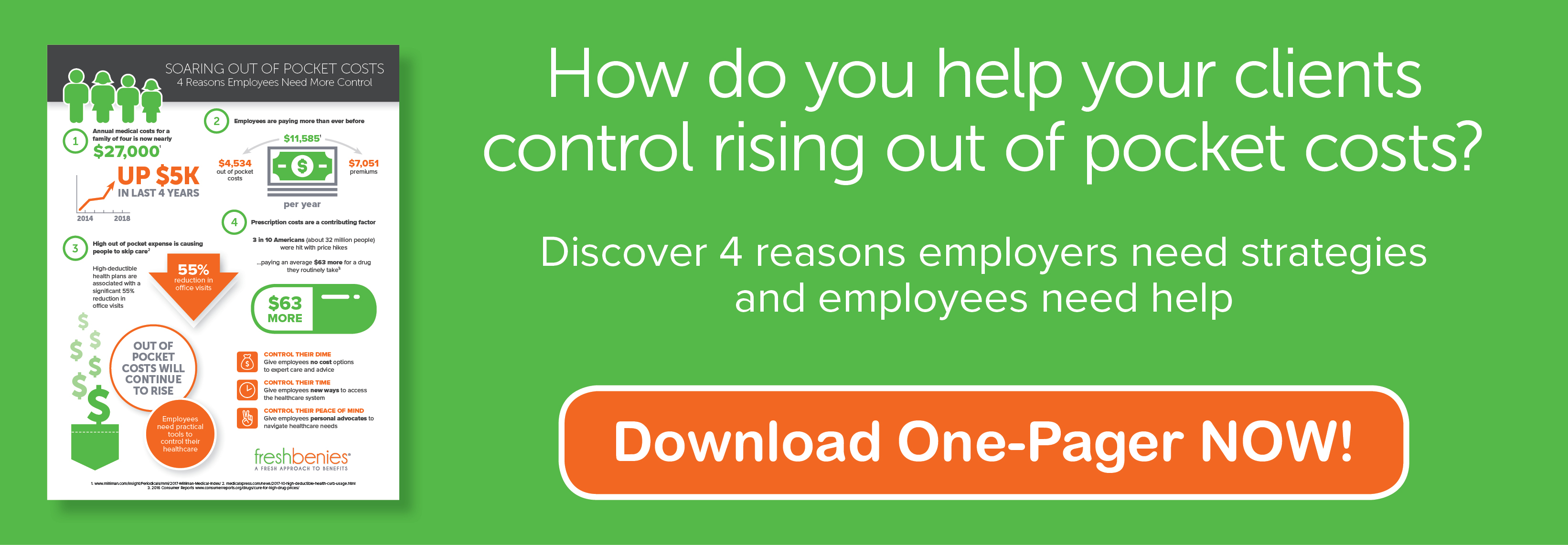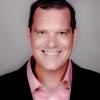BROKER EXPO 2018: OUR TEAM’S TOP TAKEAWAYS
Did you make it to San Diego for the BenefitsPRO Expo? From machine learning to the Broker of the Year Panel, it was a terrific 3 days of connecting with benefits experts from all over the country.
If you were there, maybe your mind is still swirling with ideas. If not, we believe sharing is caring and hope this recap helps to fill you in.
Below is a compiled list of 10 takeaways from our team....
1. It’s 2010 (well, kind of…)
Yes, Billy Bridwell knows it’s 2018. But, in his presentation with Reid Rasmussen, Must-Have Cost Containment Strategies to Help Employers Survive and Thrive, he explained we’re at a key moment in our industry – just like 2010 when Healthcare Reform was taking place with ACA. Bridwell pointed out those who thrived were the people who dove in and implemented change. He went on to explain that brokers can thrive by changing the conversation from constant rate increases to educating clients on other ways to create personalized benefits programs on a self-funded model. He believes brokers have a great opportunity to deliver new ideas, products, and strategies in the current environment.
2. Technology will close the gap on a better experience
What do technology advancements mean for brokers and employers? David Contorno explained it’s all about an enhanced user experience. That means better utilization of effective tools, higher employee satisfaction with the benefit plans, and higher revenue when performance-based compensation is in place. He shared six technology advancements tied to these improvements:
1. Structured data that enhances plan design
2. Centralization of multiple data inputs via a single experience
3. Artificial Intelligence (AI) to enhance and simplify communications.
4. Incentives delivered with instant feedback
5. Trackability that monitors and analyzes behavior for improvement
6. On demand-mobile technology that meets the employee (patient) where they’re interacting
The expectations for technology in the benefits industry have already been set. We need to ensure we meet those expectations with a digital experience that’s easy to use, proactive and personalized.
In a separate session called Alexa the Broker, Tonia Degner and Reid Rasmussen spoke in depth about how AI and Machine Learning will impact the industry. They encouraged brokers and carriers to relentlessly pursue a great customer experience as they develop and use these new technologies.
3. There is a move toward high-value care
Dr. Gurpreet Dhaliwal (Professor of Medicine, University of California) presented a keynote with a view of the future from a physician’s perspective. He emphasized a renewed focus on patient experience. Previously known as bedside manner, Dr. Dhaliwal made the point that growing technology now requires physicians to develop their “webside manner.” He expressed some frustration with technology, saying “Friends don’t let friends Google their symptoms” (we agree!) and “It’s time for the computer to start working for the doctor, not the other way around.” Check out this videowith Dr. Dhaliwal. Yet, Dr. Dhaliwal clearly sees new methods of care as a positive. Specifically, he called telehealth “the most effective way to treat people.” Technology will continue to dramatically support medicine in ways that support physicians in delivering valuable care to patients.
4. Healthcare is a great, yet complex equalizer
Bobby Jindal, Governor of Louisiana from 2008 to 2016, summarized why healthcare is so important to all Americans (and politicians): when a person is sick, medicine is the great equalizer of the rich and the poor. As succinct a point as that is, Jindal referenced two numbers that highlight the complexity of healthcare...
1. Medicare is 130,000 pages of rules and regulations
2. The government sets 10,000 medical prices in every county across the country
What will the future bring? As Jindal notes, “The populous forces are creating change, and an unforeseeable future political environment.” The climate seems ripe for disruption.
5. Politics needs to go back to the drawing board (or kitchen table…)
According to veteran political strategist and Interim Chair of the Democratic National Committee, Donna Brazile, American people want more than what’s being delivered. Both Republicans and Democrats are expecting changes in the upcoming mid-term elections. Ms Brazile described it this way: “We have learned that crying out loud and whining doesn’t get you very far. ...They (the voters) want ideas and we have to go back to the drawing board and find a message that can improve the economy. We have to show we care about the American people. We have to get back to discussing and delivering on kitchen table issues.”
6. MORE ideas and more coming!
We heard from many brokers who are adding new products to their lineup. Five years ago, the exhibit hall looked very different than what we saw this week. Double-wide booths that used to be filled with carriers are now taken over by multiple single-wide booths filled with newcomer companies with innovative ideas for the healthcare and employee benefits industries: Rx solutions, financial wellness, ben admin systems, TPAs, non-insurance benefits, analytics providers, high-performance surgical centers, direct primary care, and captives to name a few. Many brokers are trying to figure out how to take advantage of these solutions for their clients – and how to pull them all together in a consulting model.
7. Broker of the Year Panel rocked!
It was a great lineup of brilliance! A few of the key ideas they shared…
• Bob Gearhart, Jr.: There are a LOT of new ideas swimming around out there and it’s easy to get overwhelmed. Pick a few new ideas you can implement and do it - don’t get overwhelmed. Just start small and execute well.
• Bob Gearhart, Sr: He made a bold statement about how he no longer runs quotes to earn a new client. Either the client is on board with what they do and how they do it, or they’re not. Bob wants to work with companies who see their vision.
• Beth Robertson: When speaking to her clients or prospects about what their experience will be with her agency/team, she refrains from using the word “seamless” because nothing is seamless. Don’t over-promise and under-deliver.
• Bret Brummit: The social media effect can make you think you’re not as successful, cutting edge, innovative, forward-thinking as your peers. Don't fall for the lie that you're not already there and doing great things for your clients.
• Julie Freidus: Discussed the importance of moving to self-funding because it holds much more promise to be a true consultant with her clients. She also talked about how she’s not a “yes man” with her clients and the importance of challenging clients when they are slow to move to a new idea.
• Billy Potter: Gave the advice that we need to figure out our “why.” He suggested that we all watch the Simon Sinek TED Talk. From there, he urged the audience to “hone your craft” because your teams and clients want to and need to be led. Also, a big CONGRATULATIONS on receiving Broker of the Year!
8. Go social, and use some strategies
Adding social media to an already busy schedule can be a challenge. Amy Evans, President of Colibri Insurance Services, led a session to highlight the opportunity and offered some doable strategies and tactics. She reminded us social media is a free method to reach our audience. Consider the adoption of these platforms: LinkedIn has 100 million active users, Facebook has 2.1 billion users, and there are 330 million followers on Twitter.
Evans stressed that social channels can be a great place to start the “Know, Like, Trust” process. She shared these tips:
• Posts should have relevant, educational content
• Be positive and authentic
• Timeliness matters – on topics and responses to those who engage
• Spend 10 minutes daily to check/respond to notifications
• Consider tools to manage multiple accounts such as Buffer or Hootsuite
• Schedule posts throughout the day
• Use a checklist to help with organization
9. Do not underestimate the importance of your marketing
57% of the purchase decision is complete before a customer even calls YOU, and 67% of YOUR buyer’s journey is now done digitally. Wendy Keneip, Partner and Coach of Q4intelligence, led a discussion panel on finding sales success at the intersection of prospecting and marketing. Here are a few key ideas shared by each of the panelists.
• Barry Cohn, President of Really Great Employee Benefits, emphasized that whatever you do, just do it! Start with one thing, do it well, and let it become part of your expertise. Then, start the next thing, do it well, and so on. Ultimately, you’ll develop the skills that build a solid marketing and prospecting plan.
• Tim Doherty, President of Pinnacle HR Solutions, shared that building a pipeline of leads stems from a solid marketing plan. This prevents you from being reliant on just a few key leads.
• Heidi Rasmussen, Co-Owner of freshbenies, talked about consistency. Keep your marketing activities consistent with your brand and consistent in timing: email consistently, post on social consistently, blog consistently, create content consistently, etc. Determine what works for you and then be consistent.
10. We need solutions in healthcare to revive the American Dream
In a TED Talk style keynote, four speakers shared things that must change in the employee benefits industry...
• Dave Chase, author and Creator of Health Rosetta, stated healthcare is stealing the American dream. He noted that the Opioid crisis is the largest public health crisis in the last 100 years and contends it was driven by a broken healthcare system. He believes that Millennials will see half their pay go to healthcare and noted that 70% of the people filing for bankruptcy had medical insurance. A key to slash healthcare costs is to improve benefit plan design.
• Dutch Rojas, Founder and CEO of Sano Surgery, gave 5 solutions to control healthcare costs. He noted that 35% of surgeries aren’t necessary and that second opinions should be required.
• David Contorno, President of Lake Norman Benefits, spoke of how the size and complexity of the healthcare system makes finding a solution difficult. He noted part of the problem is too many competing interests (carriers, pharmacy benefit managers, providers, etc.)…
• Kevin Trokey, Founding Partner and Coach at Q4Intelligence, stressed non-insurance solutions are a big part of the equation to solve healthcare spend. These services alongside a medical plan enhance the benefits to slash healthcare costs. He challenged that advisors aren’t adding these services as often as they could be. Education, communication, engagement and transparent medical management are all valuable.
Now it’s your turn! What insights did you gain at this year’s Broker Expo? Which sessions sparked new ideas? Comment below or email me at david@freshbenies.com.
















